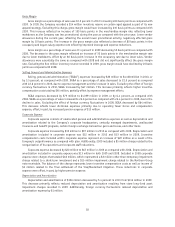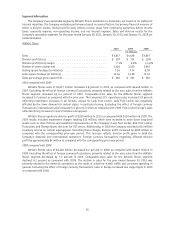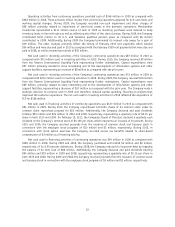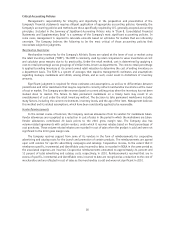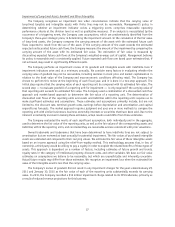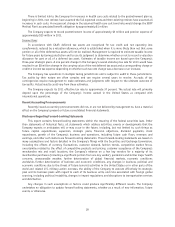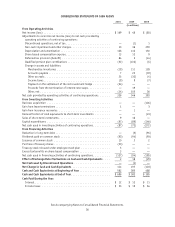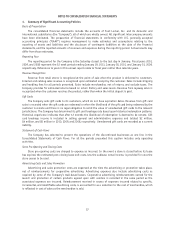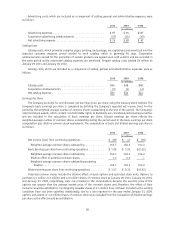Foot Locker 2010 Annual Report Download - page 47
Download and view the complete annual report
Please find page 47 of the 2010 Foot Locker annual report below. You can navigate through the pages in the report by either clicking on the pages listed below, or by using the keyword search tool below to find specific information within the annual report.
Share-Based Compensation
The Company estimates the fair value of options granted using the Black-Scholes option pricing model. The
Company estimates the expected term of options granted using its historical exercise and post-vesting
employment termination patterns, which the Company believes are representative of future behavior. Changing
the expected term by one year changes the fair value by 6 to 8 percent depending if the change was an increase
or decrease to the expected term. The Company estimates the expected volatility of its common stock at the
grant date using a weighted-average of the Company’s historical volatility and implied volatility from traded
options on the Company’s common stock. A 50 basis point change in volatility would have a 1 percent change to
the fair value. The risk-free interest rate assumption is determined using the Federal Reserve nominal rates for
U.S. Treasury zero-coupon bonds with maturities similar to those of the expected term of the award being valued.
The expected dividend yield is derived from the Company’s historical experience. A 50 basis point change to the
dividend yield would change the fair value by approximately 4 percent. The Company records stock-based
compensation expense only for those awards expected to vest using an estimated forfeiture rate based on its
historical pre-vesting forfeiture data, which it believes are representative of future behavior, and periodically will
revise those estimates in subsequent periods if actual forfeitures differ from those estimates. The Black-Scholes
option pricing valuation model requires the use of subjective assumptions. Changes in these assumptions can
materially affect the fair value of the options. The Company may elect to use different assumptions under the
Black-Scholes option pricing model in the future if there is a difference between the assumptions used and the
actual factors that become known over time.
Pension and Postretirement Liabilities
The Company determines its obligations for pension and postretirement liabilities based upon assumptions
related to discount rates, expected long-term rates of return on invested plan assets, salary increases, age, and
mortality, among others. Management reviews all assumptions annually with its independent actuaries, taking
into consideration existing and future economic conditions and the Company’s intentions with regard to the
plans.
Long-Term Rate of Return Assumption — The expected rate of return on plan assets is the long-term rate of
return expected to be earned on the plans’ assets and is recognized as a component of pension expense. The rate
is based on the plans’ weighted-average target asset allocation, as well as historical and future expected
performance of those assets. The target asset allocation is selected to obtain an investment return that is
sufficient to cover the expected benefit payments and to reduce future contributions by the Company. The
expected rate of return on plan assets is reviewed annually and revised, as necessary, to reflect changes in the
financial markets and our investment strategy. The weighted-average long-term rate of return used to determine
2010 pension expense was 7.22 percent. A decrease of 50 basis points in the weighted-average expected
long-term rate of return would have increased 2010 pension expense by approximately $3 million. The actual
return on plan assets in a given year typically differs from the expected long-term rate of return, and the resulting
gain or loss is deferred and amortized into expense over the average life expectancy of its inactive participants.
Discount Rate — An assumed discount rate is used to measure the present value of future cash flow
obligations of the plans and the interest cost component of pension expense and postretirement income. The
discount rate selected to measure the present value of the Company’s U.S. benefit obligations at January 29,
2011 was derived using a cash flow matching method whereby the Company matches the plans’ projected
payment obligations by year with the corresponding yield on the Citibank Pension Discount Curve. The cash flows
are then discounted to their present value and an overall discount rate is determined. The discount rate selected
to measure the present value of the Company’s Canadian benefit obligations at January 29, 2011 was developed
by using the plan’s bond portfolio indices, which match the benefit obligations. The weighted-average discount
rates used to determine the 2010 benefit obligations related to the Company’s pension and postretirement plans
were 4.98 percent and 4.60 percent, respectively. A decrease of 50 basis points in the weighted-average discount
rate would have increased the accumulated benefit obligation of the pension plans at January 29, 2011 by
approximately $29 million, while the effect on the postretirement plan would not have been significant. Such a
decrease would not have significantly changed 2010 pension expense or postretirement income.
28


